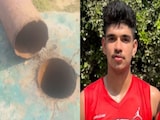Scientists have long believed that truly blue fruits do not exist in nature. Even common "blue" foods such as blueberries or blue corn are actually shades of purple or indigo. But a rare rainforest tree proves otherwise. The Elaeocarpus angustifolius, known as the blue quandong, blue fig, or blue marble tree, grows in Australia, Papua New Guinea, and parts of Indonesia, and produces the only known fruit with a genuine, vivid blue appearance.
The fruit looks so bright and metallic that many assume its colour is digitally edited. But researchers confirm that the blue marble fruit's intense hue is natural and does not come from pigments. Instead, it results from structural colouration, a light-bending optical effect similar to the colours seen in peacock feathers or butterfly wings.
Studies published in Nature and PNAS reveal that the fruit's skin contains ultra-thin layers of cellulose arranged in nanoscale patterns. These layers reflect only blue wavelengths of light while cancelling out all others. Interestingly, when scientists attempted to extract blue pigment from the fruit, the material turned grey, proving the colour isn't chemical.
This structural blue makes the fruit one of only six known in the world to use this phenomenon. Researchers believe the tree evolved this feature to attract birds, which see blue and UV light very clearly. The glossy blue fruit stands out even under dense rainforest shade, helping birds locate it from long distances and spread its seeds widely. The blue quandong remains an evolutionary mystery and a rare example of how nature uses physics, not pigments, to create extraordinary colours.















